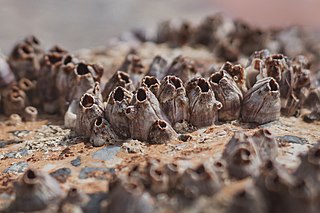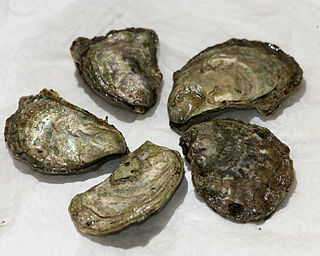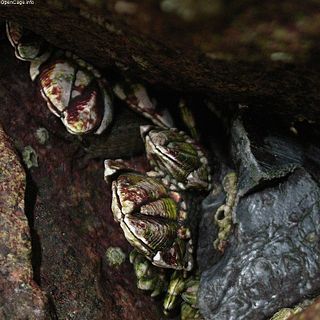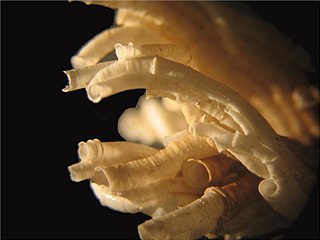
Barnacles are a type of arthropod constituting the subclass Cirripedia in the subphylum Crustacea, and are hence related to crabs and lobsters. Barnacles are exclusively marine, and tend to live in shallow and tidal waters, typically in erosive settings. Around 1,000 barnacle species are currently known.

Balanus is a genus of barnacles in the family Balanidae of the subphylum Crustacea.

Austrominius modestus is a species of barnacle in the family Elminiidae, native to Australia, Tasmania and New Zealand, but now spread to Britain and the north west coasts of Europe. It reaches a maximum size of about 10 millimetres in diameter.
Marine larval ecology is the study of the factors influencing dispersing larvae, which many marine invertebrates and fishes have. Marine animals with a larva typically release many larvae into the water column, where the larvae develop before metamorphosing into adults.

Acorn barnacle and acorn shell are vernacular names for certain types of stalkless barnacles, generally excluding stalked or gooseneck barnacles. As adults they are typically cone-shaped, symmetrical, and attached to rocks or other fixed objects in the ocean. Members of the barnacle order Balanomorpha are often called acorn barnacles.

Semibalanus balanoides is a common and widespread boreo-arctic species of acorn barnacle. It is common on rocks and other substrates in the intertidal zone of north-western Europe and both coasts of North America.

Ostrea lurida, common name the Olympia oyster, after Olympia, Washington in the Puget Sound area, is a species of edible oyster, a marine bivalve mollusk in the family Ostreidae. This species occurs on the northern Pacific coast of North America. Over the years the role of this edible species of oyster has been partly displaced by the cultivation of non-native edible oyster species.

Amphibalanus improvisus, the bay barnacle, European acorn barnacle, is a species of acorn barnacle in the family Balanidae.

Balanus balanus is a species of acorn barnacle in the Balanidae family. It is native to the colder seas of the northern hemisphere.

Balanus crenatus is a species of acorn barnacle in the Balanidae family. It is found in the North Pacific and the North Atlantic Ocean.

Balanus perforatus is a species of barnacle in the family Balanidae. It is found on the lower shore and in the neritic zone in the warm temperate parts of the eastern Atlantic Ocean.

Pollicipes polymerus, commonly known as the gooseneck barnacle or leaf barnacle, is a species of stalked barnacle. It is found, often in great numbers, on rocky shores on the Pacific coasts of North America.

Megabalanus tintinnabulum is a species of large barnacle in the family Balanidae. It is the type species of the genus. The specific name comes from the Latin tintinnabulum meaning a handbell and probably refers to the fact that small groups of barnacles resemble clusters of miniature bells.

Amphibalanus eburneus, the ivory barnacle or American acorn barnacle, is a species of acorn barnacle in the family Balanidae. It occurs on the east coast of North America, the Caribbean Sea and Gulf of Mexico.

Megabalanus coccopoma, the titan acorn barnacle, is a tropical species of barnacle first described by Charles Darwin in 1854. Its native range is the Pacific coasts of South and Central America but it is extending its range to other parts of the world.

Capitulum is a monotypic genus of sessile marine stalked barnacles. Capitulum mitella is the only species in the genus. It is commonly known as the Japanese goose barnacle or kamenote and is found on rocky shores in the Indo-Pacific region.

Ficopomatus enigmaticus, commonly known as the Australian tubeworm, is a species of serpulid tubeworms. Their true native range is unknown, but they probably originated in the Southern Hemisphere, perhaps from the Indian Ocean and the coastal waters of Australia. Today they have a cosmopolitan distribution, having been introduced to shallow waters worldwide. The Australian tubeworm is an invasive species that dominates and alters habitats, reduces water quality, depletes resources, and causes biofouling.

Coronula diadema is a species of whale barnacle that lives on the skin of humpback whales and certain other species of whale. This species was first described by Carl Linnaeus in the 1767 12th edition of his Systema Naturae.

Streblospio benedicti is a small polychaete native to the Western Atlantic, where its distribution ranges from the Gulf of Saint Lawrence to Venezuela. Sexual maturity is reached at around 9 to 14 weeks and populations and individuals may vary during development. It can be found in the mudflats and soft sediments of estuaries and coastal waters. Its general habitat includes oyster reefs, mangroves, grass beds, marinas, and docks while the tidal range where S. benedicti can be found is subtidal to intertidal. Additionally, S. benedicti can tolerate a broad range of temperatures and salinities. Due to its tolerance of high organic contents, S. benedicti is a pioneer organism of new habitats that it settles in. Furthermore, despite its small size, only reaching a maximum of 20 mm (0.79 in) in length, S. benedicti plays an important role in estuarine food webs as it can reach high population densities and is a substantial grazer of phytoplankton.



















